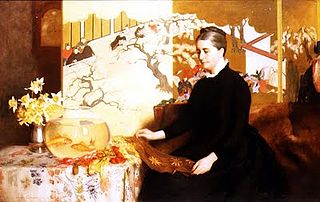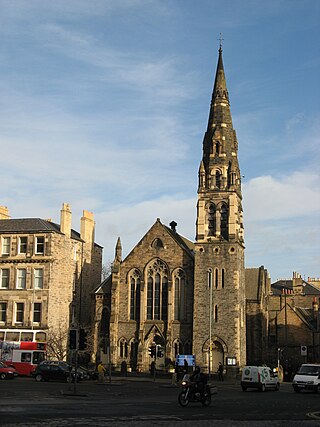
Kirkcudbright is a town at the mouth of the River Dee in Dumfries and Galloway, Scotland, southwest of Castle Douglas and Dalbeattie. A former royal burgh, it is the traditional county town of Kirkcudbrightshire.

Robert Jameson FRS FRSE was a Scottish naturalist and mineralogist.
Matthew Forster Heddle FRSE was a Scottish physician and amateur mineralogist active through the 19th century.

Balmaghie, from the Scottish Gaelic Baile Mhic Aoidh, is an ecclesiastical and civil parish in the historical county of Kirkcudbrightshire in Dumfries and Galloway, Scotland and was the seat of the McGhee family. It is bordered by the River Dee to the north and east. Threave Castle stands on an island in the river. The River Dee is commonly known as the Black Water of Dee on the northern border, the name changes with the meeting of the Water of Ken to the north west and is then known as Loch Ken along the eastern border. Balmaghie parish borders Girthon to the west and Tongland and Twynholm to the south. The closest market town is Castle Douglas, about 6 miles from Balmaghie Kirk.

Parton is a hamlet situated on the banks of the River Dee in the historical county of Kirkcudbrightshire, Dumfries and Galloway, Scotland.

The Clan MacLellan is a Scottish clan of the Scottish Lowlands. The clan does not currently have a chief therefore it is considered an Armigerous clan. in Edinburgh at the gathering of the clans in 2009 the Maclellan clan were led up the royal mile by Steven McLelland living in carlisle now,

Restalrig is a small residential suburb of Edinburgh, Scotland. It is located east of the city centre, west of Craigentinny and to the east of Lochend, both of which it overlaps. Restalrig Road is the main route through the area, running from London Road, at Jock's Lodge, to Leith Links. It is in the ward of Lochend.

Dumfries Academy is one of four secondary schools in Dumfries in south west Scotland. It is a state funded secondary school for both girls and boys. The schools moto is "doctrina promovet" which translates from Latin to "learning promotes" which the school emphases within their "vision, values and aims". There are two notable buildings; the Minerva Building 1895-7 by F J C Carruthers and a later building by County Architect John R Hill, 1936.

James Cadenhead was a Scottish landscape and portrait painter.

Robert Ferguson of Raith, was at various times a Whig Member of Parliament for Fifeshire, Haddingtonshire and Kirkcaldy Burghs, and at the time of his death he was Lord Lieutenant of the county of Fife.

Kenmure Castle is a fortified house or castle in The Glenkens, 1 mile (1.6 km) south of the town of New Galloway in Kirkcudbrightshire, Galloway, south-west Scotland. The site was occupied from the Middle Ages, and the house incorporates part of a 17th-century castle. This was remodelled in the 19th century, but the house has been derelict since the mid-20th century. It was the seat of the Gordon family of Lochinvar, later raised to the peerage as Viscounts of Kenmure. The ruin is a scheduled monument.
John Douglas of Pinkerton was a Scottish architect who designed and reformed several country houses in the Scottish Lowlands. His work deserves to be noted for what the 2002 history of Scottish architecture remarks as an approach "of relentless surgery or concealment.". His most notable works are Killin and Ardeonaig Church, Stirlingshire (1744); Archerfield House, East Lothian (1745); Finlaystone House, Renfewshire (1746–47), Wardhouse (Gordonhall), Insch, Aberdeenshire (1757); and Campbeltown Town Hall, Argyll and Bute (1758–60). Several of these are listed buildings.

Gourlay Steell RSA was a 19th-century Scottish artist.

John Starforth (1822-1898) was an English-born architect and architectural author associated solely with work in Scotland, mainly working in Lothian, Dumfries & Galloway, and the Scottish Borders.
Donald Esme Innes FRSE MC was a 20th century Scottish geologist.

John Rogerson was a Scottish physician at the court of Catherine the Great of Russia.
Alexander Thoms FRSE (1837–1925) was a 19th/20th century Scottish mineralogist. His collection of rocks and minerals form a core part of the collection within the Hunterian Museum and Art Gallery in Glasgow.

Queen Street is the northernmost east-west street in Edinburgh's First New Town. It begins in the east, at the Scottish National Portrait Gallery. It links York Place with the Moray Estate.

Harold Ogle Tarbolton FRIBA (1869–1947) was a 19th/20th century British architect, mainly working in Scotland. He was affectionately known as Tarrybreeks. In later life he went into partnership with Sir Matthew Ochterlony to create Tarbolton & Ochterlony.

Greyfriars Church, Dumfries, is a Category A listed building in Dumfries, in southwest Scotland. The current Greyfriars Church building was built from 1866 to 1868 in the Victorian Gothic style, designed by architect John Starforth. It is situated in a prominent position at the top of the High Street, and is constructed of local red sandstone taken from Locharbriggs Quarry. The building has an abundance of ornate decorative stonework, including impressive figures and foliage around the entrance doorway. These carvings are attributed to local stonemason and sculptor, William Flint.

















